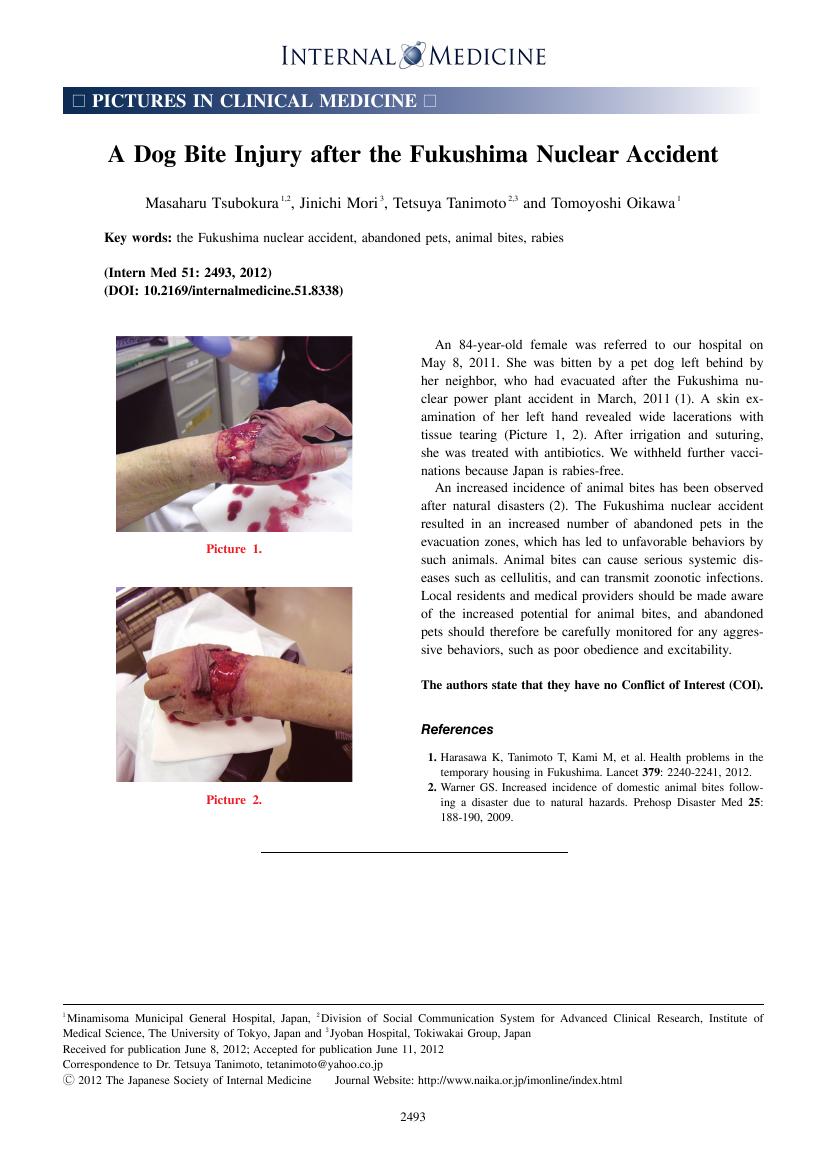- 著者
- Ken Okai Masaharu Tsubokura Tetsuya Tanimoto Yukio Kanazawa
- 出版者
- 一般社団法人 日本内科学会
- 雑誌
- Internal Medicine (ISSN:09182918)
- 巻号頁・発行日
- vol.51, no.15, pp.2073-2073, 2012 (Released:2012-08-01)
- 参考文献数
- 2
- 被引用文献数
- 1
- 著者
- Masaharu Tsubokura Jinichi Mori Tetsuya Tanimoto Tomoyoshi Oikawa
- 出版者
- 一般社団法人 日本内科学会
- 雑誌
- Internal Medicine (ISSN:09182918)
- 巻号頁・発行日
- vol.51, no.17, pp.2493-2493, 2012 (Released:2012-09-01)
- 参考文献数
- 2
- 被引用文献数
- 2 2
14 0 0 0 OA Underlying background of the current trend of increasing HPV vaccination coverage in Japan
- 著者
- Mira Namba Yudai Kaneda Chiharu Kawasaki Rajeev Shrestha Tetsuya Tanimoto
- 出版者
- National Center for Global Health and Medicine
- 雑誌
- Global Health & Medicine (ISSN:24349186)
- 巻号頁・発行日
- pp.2023.01010, (Released:2023-05-25)
- 参考文献数
- 10
- 被引用文献数
- 3
Cervical cancer is prevalent among women, with a reported 604,127 cases in 2020 worldwide. The incidence of cervical cancer has been mitigated in most high-income countries by promoting the human papilloma virus (HPV) vaccine. However, in Japan, cervical cancer is still a leading cause of mortality and the most prevalent cancer among women aged between 15 and 39. This can be attributed to the 7-year suspension of HPV vaccination recommendations by the Japanese government. A decline in vaccination coverage followed this suspension, caused by a small number of reported adverse events, resulting in a steep decline in vaccination coverage from over 70% to less than 1%. However, there have been indications of a change in trend in Japan. In 2020, a group of volunteer doctors initiated awareness-raising activities through social networking services and other platforms, and the target population that received at least one dose of the vaccine in 2020 increased to 15.9%. Additionally, in July 2020, the Japanese government approved the updated 9-valent HPV vaccine and resumed recommendations in November 2021. As a result, 30.1% of those eligible for routine HPV vaccination received at least one dose of the vaccine from April to September, 2022. However, the HPV vaccine coverage in Japan is still far from the 90% recommended by the World Health Organization, and continued communication and education on the vaccine’s benefits are necessary to achieve optimal coverage.
- 著者
- Yudai Kaneda Kenzo Takahashi Akihiko Ozaki Tetsuya Tanimoto
- 出版者
- National Center for Global Health and Medicine
- 雑誌
- GHM Open (ISSN:2436293X)
- 巻号頁・発行日
- pp.2023.01006, (Released:2023-07-16)
- 参考文献数
- 7
- 被引用文献数
- 2
The “Hiroshima Vision”, unveiled at the G7 Hiroshima Summit in 2023, leaves room for enhancement in the specific content of equitable global vaccine distribution plans. Despite the efforts of COVID-19 Vaccines Global Access (COVAX), vaccine supply faces severe disparities, with high-income countries receiving a disproportionately larger share. To mitigate future public health crises, mechanisms proven by past instances, such as establishing regional vaccine hubs, promoting technology transfers, and considering early patent rights relinquishment, need to be implemented. Correcting vaccine inequity necessitates learning from the COVID-19 pandemic and demands global cooperation and consensus from the G7.
- 著者
- Kenji Tsuda Kazuaki Sudo Goro Goto Makiko Takai Tatsuo Itokawa Takahiro Isshiki Naoko Takei Tetsuya Tanimoto Tsunehiko Komatsu
- 出版者
- 一般社団法人 日本内科学会
- 雑誌
- Internal Medicine (ISSN:09182918)
- 巻号頁・発行日
- vol.55, no.4, pp.347-352, 2016 (Released:2016-02-15)
- 参考文献数
- 32
- 被引用文献数
- 29
Objective Adherence to rehabilitation exercise is much lower in patients with hematologic malignancies (22.5-45.8%) than in patients with solid tumors (60-85%) due to the administration of more intensive chemotherapeutic regimens in the former. Virtual reality exercise can be performed even in a biological clean room and it may improve the adherence rates in elderly patients with hematologic malignancies. Thus, in this pilot study, we aimed to investigate the feasibility and safety of virtual reality exercise intervention using Nintendo Wii Fit in patients with hematologic malignancies receiving chemotherapy. Methods In this feasibility study, 16 hospitalized patients with hematologic malignancies aged ≥60 years performed virtual reality exercise for 20 minutes using the Nintendo Wii Fit once a day, five times a week, from the start of chemotherapy until hospital discharge. The adherence rate, safety, and physical and psychological performances were assessed. Results The adherence rate for all 16 patients was 66.5%. Nine patients completed the virtual reality exercise intervention with 88 sessions, and the adherence rate was 62.0%. No intervention-related adverse effects >Grade 2, according to National Cancer Institute Common Terminology Criteria for Adverse Events version 3.0, were observed. We noted maintenance of the physical performance (e.g., Barthel index, handgrip strength, knee extension strength, one-leg standing time, and the scores of timed up and go test and Instrumental Activities of Daily Living) and psychosocial performance (e.g., score of hospital anxiety and depression scale). Conclusion Virtual reality exercise using the Wii Fit may be feasible, safe and efficacious, as demonstrated in our preliminary results, for patients with hematologic malignancies receiving chemotherapy.

